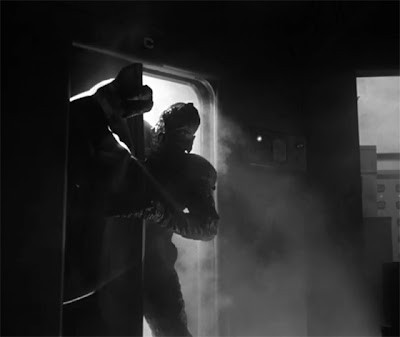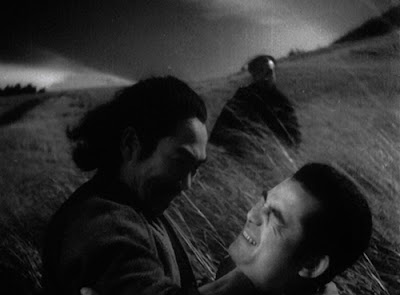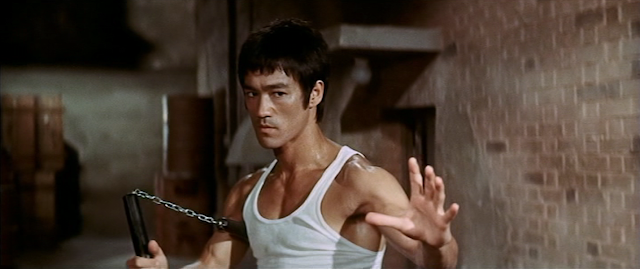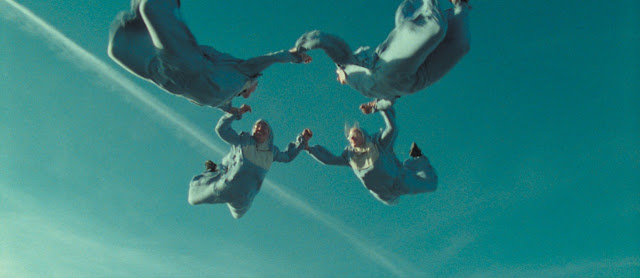Director: Fede Alvarez
Stars: Jane Levy, Shiloh Fernandez, Lou Taylor Pucci
Genre: Horror, Splatter
Not so much a remake as it is a reimagining/reboot of the 1981 splatter horror classic
The Evil Dead, this time with a different director and cast and a much bigger budget. But can it live up to the cult original?
The story is a bit tweaked from the original's plot, but the main concept is still there: a bunch of kids stuck in a cabin in the middle of nowhere with some evil demons. This time we have a girl, Mia, who is taken into the woods by her brother and her friends in order for her to rid herself of her heroin addiction cold turkey. Of course, in time, they're pretty much all possessed into demons.
The idea of having a heroin addict as the main character (played quite well by Jane Levy) was an interesting one. Unfortunately it wasn't used to full effect. It allowed the potential for the main character (Mia) to be pitted against the rest of the characters, thinking that her stories of demons and evil trees were nothing more than a ploy for her to be taken home, back to her heroin addiction. This was utilized to an extent but could have been a bit more prominent. It was nice for the few minutes it lasted though.
It also allowed for the characters to, at first, wave off her crazy stories and weird attitude as just the symptoms of drug withdrawal and not, as they later realized, demonic possession.
I'm also glad that the film didn't try and tie in any blatant anti-drug messages. They merely portrayed the symptoms of drug-use and withdrawal but they never really became preachy about the issue. In fact they made the heroin addict into a hero, something that is not seen often.
Then there is my personal theory that the whole film is a film about drug addiction and overcoming a drug problem. Mia goes to a cabin to quit heroin cold turkey and in the process she feels the intense pains of withdrawal (perhaps represented in the self-mutilation she partakes in as a demon), she feels as if she is dying and losing control and as if every one is against her (she becomes possessed and tries to kill her friends), and then, [spoilers here] after much suffering and hardship she is cured from her addiction (reverted from demon form, the possession representing the evil she went to the cabin to get rid of) and is a new person (the fire and her burial representing her cleansing). She confronts her inner demons (quite literally) head on and overcomes them (Mia fighting the Abomination Mia at the end). Plus there seems to be the motif of needles and syringes throughout the film. It's just a theory.

The acting in this film ranges from awful to quite bad, with the only exception being Jane Levy. If it wasn't for Jane Levy this film would be much worse. I'd go so far as to say that she almost carried the entire film. I'm not so much referring to her as Mia in human form, which is solidly acted though a pretty mediocre character, but rather to Mia in deadite form. Deadite Mia is pretty fucking awesome. She's wonderfully creepy, twisted, explicit, crude, and actually kind of hilarious. This film pretty much consists of scenes with Deadite Mia and then some other stuff in between.
It was a smart move to cast a woman as the main character. No male actor could have upstaged Bruce Campbell (even though Bruce didn't really develop his persona until the sequels) and trying to do so would have been to no avail. Casting a woman immediately prevents comparison between the two.
The rest of the cast however does a very poor job and their characters are just awful. They are as stereotypical as can be and not likable in any way. There is of course the jock, the stoner, the smart girl, and the dumb girlfriend. So, yeah, it's pretty much the entire Scooby gang. They all suck. And their introductions are just terrible. The first twenty to thirty minutes of this film is some of the worst I've ever had to sit through.
I understand that the film has to introduce its characters somehow so it can get on with the film, but holy crap it was done terribly. Expect to hear things like "That's what big brothers are for" to inform you that he is indeed her brother or clever career information like "I'm a nurse" or my favorite "And there's Eric over there" even though all the character were supposed to already know each other. Even the dog had a cheesy introduction...and his name was Grandpa (I'll admit that I chuckled at the thought of their grandfather being a dog).
Of course the original
Evil Dead was pretty poorly acted as well and didn't exactly have the greatest character development. But here's the difference: the original
Evil Dead was a film made by a couple of kids in the woods with a small budget. The remake to
Evil Dead was made with a large crew and an absurdly large budget. At least the original
Evil Dead made sure to get to the point of the film quickly and to not even attempt any form of back story or other nonsense that is irrelevant to the film.
The
Evil Dead series is noted by fans for it's blending of Horror and Comedy, more so in the
second and
third installments but even the first one had a fantastic level of subtle, though never unintentional, humor.
This remake kind of seems to have forgotten the humor. There is a certain level of Black Comedy, sure, and at times the film feels like it's fairly self-conscious of itself, but it misses the Evil Dead humor almost completely. The humor in here consists of ugly looking demons shouting obscenities. That's it. A demon shouting "Let me suck your cock, pretty boy" or "Kiss me, you dirty cunt"
has its charm and is funny in its way but for that to be the sole source of humor is extremely cheap and lacks any sense of subtlety or wit.
Not to mention that nearly all the film's humor relies on Deadite Mia. I'm not even exaggerating. Almost all the film's humor comes from her. Another reason why this film would be much worse without Jane Levy's impressive performance.
Then, opposite to the comedic elements, is the over-sentimentality, nearly to the point of melodrama. Why did they try to set up back stories for the characters? Wasn't them being there to help their heroin-addicted friend enough? In the original
Evil Dead we didn't even know why those kids went to that cabin yet it still worked out better than it did in this remake.
The brother-sister relationship is riddled with so much over-sentimentality that it nearly ruins the entire film. It's so cheesy, it's so unbelievable, it's so unnecessary.
The original
Evil Dead did have a bit of sentimentality, I'll admit as much, but it was nowhere near as overdone as it is here. Ash made some stupid decisions because he felt deeply for his girlfriend but he still pushed through and got the job done. The fucking brother in this movie is the most overly sentimental, dramatic asshole I have ever seen and it gets to the point where you not only hate him as a character but you hate that his over-sentimentality affects the film's plot in such a major way. It's annoying and unbelievable. I really hate that guy.
The film took itself too serious. It tried to give too much back story to poorly written characters. It added way too much sentimentality to the brother and sister characters. These three things are the three main reasons this film isn't nearly as good as it could of been.
The film's special effects, on the other hand, were pretty excellent. It really is the natural evolution/modernization of the gore from the first film.
It's more violent, bloodier, and gruesome than anything else in the series. It's not quite torture porn (though at times it may come very close) but it's a Splatter film no doubt. Which is good. Right? Well, yes and no. Great, over-the-top gore is fantastic, it's what gave the original
Evil Dead movies much of their appeal.
This remake has great gore effects, but it relies on them too heavily. This film is really just a gorefest and nothing more. It doesn't try to scare you, instead it just tries to shock you and gross you out...a tired attempt in the horror genre.
The original Evil Dead, more so than even the second one, creates a fantastic unsettling and claustrophobic atmosphere and was actual kind of creepy at times and, in addition, had some awesome gore. This remake doesn't do that; it's creepy at times and occasionally acts like it's creating some sort of atmosphere but in the end it's all-gore-no-substance.
Don't get me wrong,
Evil Dead was never a psychological horror--it's a Splatter film first and always should be--but still, to rely completely on gore and effects and gross-outs and even the petty jump scares is pretty cheap.
Also, the film claims that no CGI was used (except for some touching up, wire removal, etc.) which is an admirable thing, but I'm calling bullshit. Yes, most of the effects were obviously practical and very impressive but a few parts looked very obviously CGI. I'm just saying.
Oh, and there is some tree rape in here. Is it as awesome as the original tree rape? It's arguable, but I'd say no.
The camerawork is, for the most part, lackluster. The signature
Evil Dead swooping shots through the woods are enjoyable, though used much less effectively compared to the original. At times the camera does well to capture some nice imagery, and the beginning of the film features some nice landscape shots, but everything is, as I said, mostly lackluster. Gone are the claustrophobic angles and the impressive movements and the well timed close-ups and in their place are things like rapid cuts during action scenes: the biggest convention of modern cinema.
Sam Raimi had some amateur camerawork in his Evil Dead, but this film has amateur camerawork without any ambition. It plays it completely safe.
Indeed the entire film plays it safe. Don't let the gore fool you, this is a very safe horror film and is just as conventional as many of the other horror remakes being released nowadays. It's not a snarky satire, not a hilarious parody, it's not even a good homage. At least last year's (slightly overrated)
The Cabin in the Woods was a bit more daring in their approach, and the fact that
The Cabin in the Woods was a better Horror Comedy, a better parody, a better satire, and quite frankly a better film than this
Evil Dead remake is extremely disappointing.
The score is actually pretty impressive and is something I could definitely imagine listening to and enjoying as a standalone experience.
Unfortunately the score, though well composed, is utilized all wrong. The music is placed in all the places you expect it to be placed. Scary music goes here to make the scene scary, sentimental music goes here to stress the dramatic nature of the scene, uplifting music goes here to create a sense of victory, etc.
Like the film as a whole it's all very conventional, uninspired and cheap. I will say that the film does have a few moments that make solid use of silence, but when you see how silence was used in the original
Evil Dead you realize the missed potential.
The original
Evil Dead was made by some kids who went out into the woods with a small budget and made a great film under tough conditions. It didn't follow the conventions of its time; they could of easily made a slasher film, which was all the rage in the 80s, and would've probably had a much more easier time pitching it to production companies and securing finances and selling tickets. But that's not the film that we got. We got a crazy Comedy Horror Splatter film with ambitious camerawork, surprisingly impressive special effects, and overall just a pretty damn awesome horror flick. These young filmmakers with their small budget broke many of the conventions of their time and made a huge mark on the horror genre.
This remake was made by a large crew with semi-experienced actors and a budget that exceeded 17 million dollars. It breaks not a single convention and is ambitious in no way at all. It follows nothing but the trends of its time and will leave no mark on the genre but rather an unpleasant stain.

















































